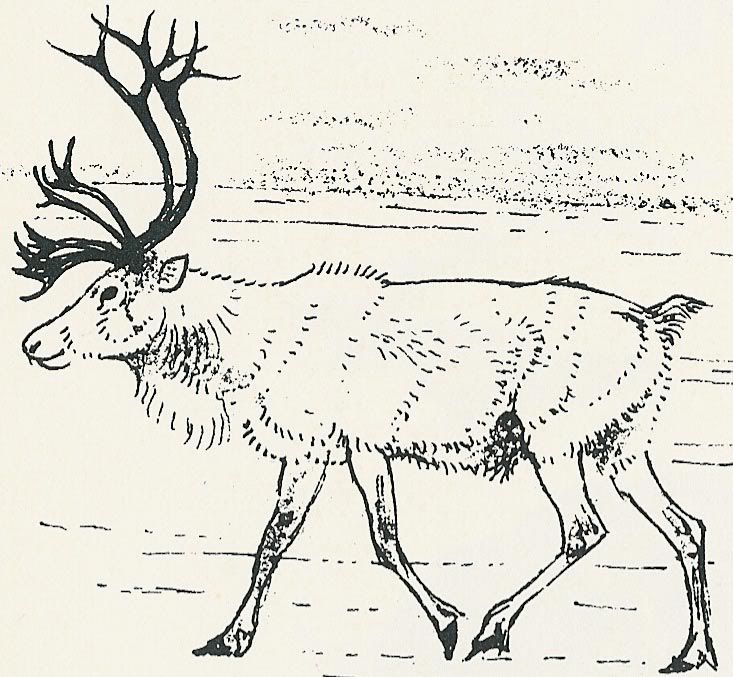|
|
Post by Peter on Apr 16, 2005 17:10:54 GMT
There is no current evidence for the presence of caribou or reindeer on the east coast of Greenland. The wild caribou (Rangifer tarandus eogroenlandicus) of north-east Greenland (c. 70°-78°N) disappeared around 1900. Further, although 22 semi-domestic reindeer were released on the east coast in the Sermilik Fjord (66°N) behind Tasiilaq about 1971, there have been no recent observations of animals, and the popula-tion is assumed extinct.
Does anyone know more?
|
|
|
|
Post by another specialist on May 9, 2005 18:06:08 GMT
Still regard as a valid subspecies...................
[ftp]http://cerfs.free.fr/english/identitepays-e.php3?genus=Rangifer&®ion1=america[/ftp]
Some authorities dispute its status, however, and regard it as a form of peary's caribou Rangifer tarandus pearji which is extant in northwest greenland.
Since the range of the two was so widely seperate,however, and since the habitats were significantly different, it seems wisest to, record this animals passing about 1950 as an effective extinction and to leave it to the zoologists to argue the finer issues of relationship...
above from the encyclopedia of vanished species by david day
|
|
|
|
Post by another specialist on May 9, 2005 18:06:25 GMT
Mol Phylogenet Evol. 1998 Oct;10(2):151-9. Related Articles, Links
Polyphyletic origin of the small-bodied, high-arctic subspecies of tundra reindeer (Rangifer tarandus).
Gravlund P, Meldgaard M, Paabo S, Arctander P.
Department of Population Biology, University of Copenhagen, Universitetsparken 15, Copenhagen O, DK-2100, Denmark. Pgravlund@zi.ku.dk
In order to investigate the origin of the three small-bodied, high-arctic subspecies of reindeer, Rangifer tarandus pearyi (the Canadian Archipelago), R. t. eogroenlandicus (East Greenland, extinct since 1900 AD), and R. t. platyrhynchus (Svalbard), samples were collected at nine localities from all six of the currently recognized subspecies of the tundra reindeer. A 203-bp-long fragment of the mitochondrial control region was sequenced from 113 reindeer (Rangifer tarandus). The now extinct subspecies R. t. eogroenlandicus was for the first time included in a molecular study; DNA was extracted from four museum specimens (skins and bones) and successfully sequenced. A polyphyletic origin for the three subspecies of small-bodied, high-arctic reindeer is suggested, with R. t. pearyi and R. t. eogroenlandicus being closely related and probably having evolved in high-arctic North America and R. t. platyrhynchus from Svalbard having evolved from Eurasian large-bodied reindeer. The small-bodied, high-arctic reindeer presumably represent ecotypes that have evolved convergently in similar high-arctic environments. Copyright 1998 Academic Press.
|
|
|
|
Post by sebbe67 on Jul 29, 2005 22:17:58 GMT
East Greenland Caribou
|
|
|
|
Post by another specialist on Jul 30, 2005 6:06:34 GMT
|
|
|
|
Post by another specialist on Aug 6, 2005 6:14:36 GMT
A. W. Barfield, 1961, prefers to call these deer Reindeer, synonymous with pearyi
|
|
|
|
Post by sebbe67 on Mar 14, 2006 17:32:44 GMT
 Source: The Doomsday book |
|
|
|
Post by another specialist on Mar 14, 2006 22:00:49 GMT
|
|
|
|
Post by another specialist on Mar 14, 2006 22:08:00 GMT
Thanks sebbe67 for the image
|
|
|
|
Post by Peter on Jun 22, 2012 20:11:34 GMT
I have a copy of this book/paper (first description of this extinct subspecies). I'm making it digital (pdf), but that will take some time. I will let you when I've finished it.  For now an image from this book, the only mounted specimen known of the extinct East-Greenland reindeer. CN. 647. Scoresby Sund, Ryder Expedition 1892. The antlers originate from another specimen. The only other available skin (CN. 592) has not been mounted.  |
|
|
|
Post by surroundx on Jun 23, 2012 1:20:23 GMT
|
|
|
|
Post by koeiyabe on Dec 4, 2015 18:39:52 GMT
 "Lost Animals (in Japanese)" by WWF Japan (1996) |
|
|
|
Post by Bhagatí on Jul 15, 2019 9:49:00 GMT
If one of you has it's digital (pdf), whether he would be so willing, to share it? If it is still possible? Provided that if it was helpful. I would be for it, personally grateful. |
|
|
|
Post by Melanie on Jul 18, 2019 17:07:16 GMT
It might be of interest that the complete monograph consists of 66 pages and not only of one. (And no: I don't have the monograph).
|
|
|
|
Post by Sebbe on Aug 5, 2024 19:55:16 GMT
|
|